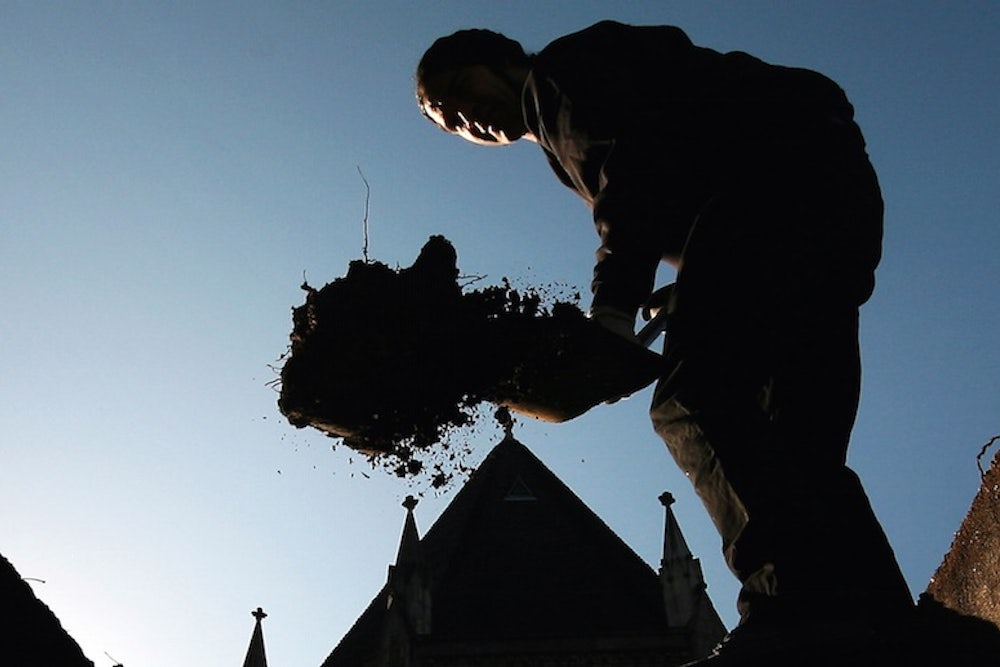On a crisp autumn morning in a field outside Henley-on-Thames, Oxfordshire, Jonny Yaxley took an aerosol can of white line marker from his truck and sprayed an 86-by-34-inch rectangle on the grass. After cutting along the outline with a spade, he mounted a small excavator and clawed off strips of turf, arranging them like jigsaw pieces on plywood sheets laid nearby.
It’s now 9am and Yaxley—45, stocky, shoulder-length brown hair whipping across his face, wearing work boots, shorts, a windbreaker, and two gold rings in his left ear—is hauling out bucketloads of clay and flint. His assistant, a South African named J.P. Brouard, lowers himself into the hole. With a tape measure Brouard gauges the depth: nearly five feet. “Yeah? Beautiful,” says Yaxley, who in September was chosen as Gravedigger of the Year at the Good Funeral Awards, the Oscars of the U.K. funeral trade. “That’s far enough.”
Yaxley used to go deeper. He started digging graves 13 years ago after taking a job with a company that maintained land, including cemeteries, for South Oxfordshire District Council. Burial space was limited, and so coffins were stacked in a single hole, often years apart. (Each new burial involved reopening a grave, and the alarming prospect of disturbing the existing tenant’s remains—as happened to Yaxley early on.) A freshly dug double grave required a seven-foot-deep hole. For a triple, it was nine feet. Hard work, especially if there was no room between the headstones to use an excavator. Perplexing, too. “A double can be a husband and wife,” says Yaxley. “But who is the third person in a treble?”
To his surprise, Yaxley, a former landscaper, found he enjoyed the craftsmanship involved in preparing a perfect grave. And he liked learning about the lives of the deceased. Even after digging close to 1,000 graves, he still tries to find out as much information as possible about the person being interred. On this day it will be a 44-year-old woman who’d had cancer since 2012 and planned her own funeral, down to the cardboard coffin that will swiftly decompose in this “natural” burial ground. She was single until six months ago. Her partner and her dogs will attend the ceremony. “It’s quite a sad one,” Yaxley says. Sometimes, emotions get the better of him. After his grandmother died, his next three burials “were all nans, so that was hard.”
A light rain falls. As Brouard levels the bottom of the grave Yaxley stands on the rim, smoothing the sidewalls with the heavy spade, four and a half feet long, that a welder friend made for him. Then he wheels his barrow towards the trees at the field’s edge. At council cemeteries the bottom of a child’s grave would be lined with sawdust. Yaxley extended the custom to adults. “It’s psychological: no one at a burial wants to see the cold, hard earth,” he says, returning with a pile of twigs and red, gold, and brown leaves, and tipping them in. The two men position planks along the edge of the hole to ensure a firm footing for the pallbearers. Four rolls of artificial turf—“butcher’s grass,” Yaxley calls it—are gently lowered over the sides of the grave.
On the carpet in front of the hole he lays two wooden beams, or putlogs, on which the coffin will rest. With the precision of waiters setting a table at an expensive restaurant, Yaxley and Brouard lay out the webbing straps that will be used to lower the coffin into the ground. It has taken three hours, but the work is done. That the mourners will never see them—they will return to fill the grave once the ceremony is over—does not matter. “This is the last thing that anyone will have done for them,” Yaxley said. “You owe it to them to do a good job.”
This piece originally appeared at The New Statesman.
